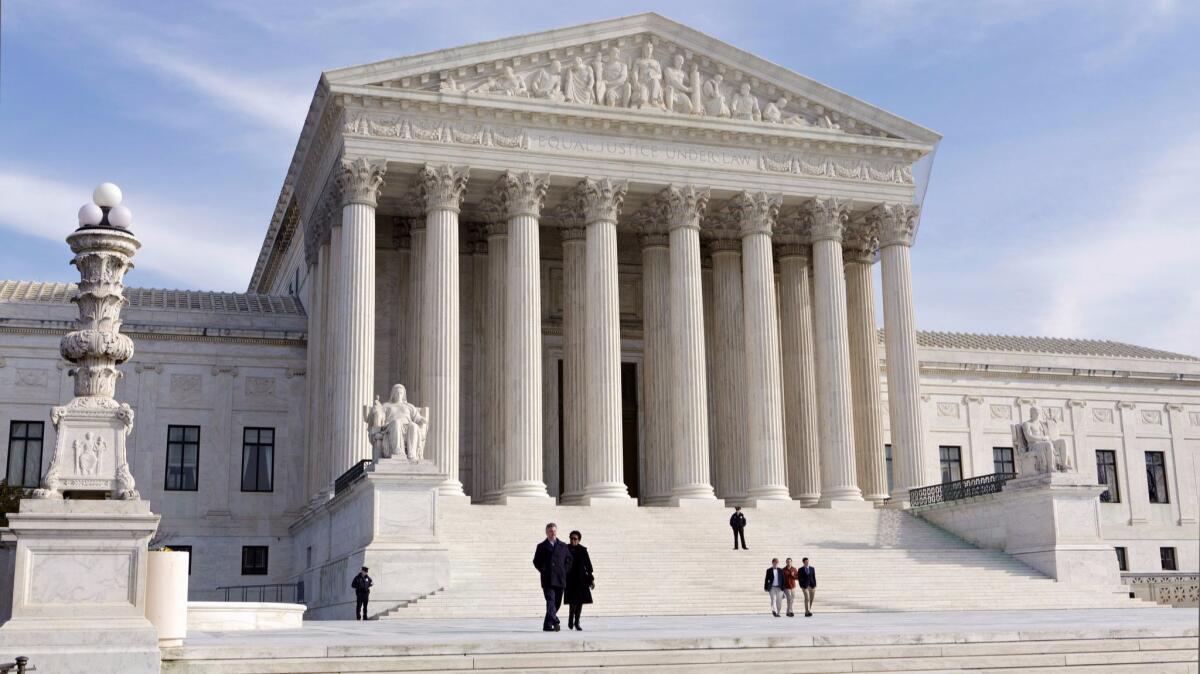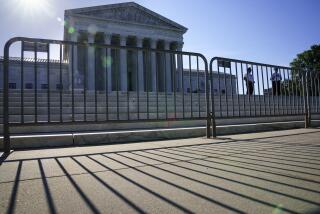Op-Ed: Forget freedom and justice. Cruelty is the thing that drives the Supreme Court

- Share via
When law enforcement officers picked up Gerald Simpson, a mentally disabled and incoherent man, wandering near Kosciusko, Miss., they allegedly drove him to the county line and left him by the side of the highway. Simpson was struck by a vehicle and killed. His family sued, but last week the U.S. Court of Appeals for the 5th Circuit threw out the case. Though the officers’ alleged actions were reckless and cruel, they did not violate Simpson’s rights, the court said.
The appeals court relied on a 1989 Supreme Court ruling, which often allows government officials to avoid accountability for the harm they do to vulnerable people in their charge. In that case, the court dismissed a suit against a county social services department that had handed a young boy, Joshua DeShaney, over to his father, who was known to be abusive. The father beat Joshua so severely that he was left with permanent brain damage — but the court said the department had no legal duty to protect the boy.
If it appears that the Supreme Court has been spreading cruelty across the land in the Trump era, it has. But this jurisprudence of cruelty goes back a half-century, with the court handling down rulings in a wide array of areas that give legal cover to government officials who mistreat the weak and defenseless.
For the last 50 years, the court has had a conservative majority and a conservative chief justice. The hallmark of their approach to the law has not been a theory of how to judge — such as “judicial restraint,” the idea that judges should leave more decisions up to elected officials. Rather, the theme running through their decisions has been a clear inclination to favor the rich and the strong, particularly when they are accused of wrongdoing. A key part of this tilt has been an indifference to the infliction of injury and pain on the vulnerable.
The modern court began in 1969, when Richard Nixon became president. Nixon campaigned on a promise to end the liberal Warren Court, which, under Chief Justice Earl Warren, had been expanding the rights of poor people, racial minorities, criminal defendants and other vulnerable people, and addressing the challenges they faced with compassion. Nixon appointed four justices in three years, including a new chief justice, Warren Burger. With those appointments, the court gained a conservative majority and it has had one ever since.
The first vulnerable group the new, less compassionate court turned against was the poor. The Warren Court had regularly sided with people on welfare, striking down offensive policies such as the “man in the house” rule, which took benefits away from children if their mother had a boyfriend. The Burger Court abandoned welfare recipients with a harsh ruling in 1970 that upheld a Maryland cap on benefits that plunged many families deeper into poverty. In that decision, the court declared that it would no longer bother itself with “the intractable economic, social” and other problems posed by welfare programs. In other words, some of the nation’s most vulnerable people were on their own.
In the decades since, the Supreme Court has approved and supported cruelty in many areas. In criminal justice, it allowed the death penalty to be carried out with a lethal injection drug cocktail that, as Justice Ruth Bader Ginsburg noted in dissent, could pose a “readily avoidable risk of inflicting severe and unnecessary pain.” Last year, the court ruled against a death row inmate with a rare medical condition, who wanted to be killed by lethal gas rather than injection, because the injection could cause him to choke on his own blood.
In the war on terror, the court has shown little interest in reining in the government’s use of torture. In 2011, it refused to hear a case filed by the American Civil Liberties Union on behalf of foreign nationals who claimed that, at the direction of the CIA, they were kidnapped and tortured overseas.
One of the court’s cruelest rulings came in an unexpected context. While it upheld the Affordable Care Act in 2012, the court struck down its Medicaid expansion provision, which required states to offer Medicaid to more people. That decision deprived millions of poor people of healthcare, and likely led to thousands of premature deaths. In that case, the court was not merely accepting the cruelty of others — it was taking medical care away.
We should not expect the court’s penchant for cruelty to change any time soon. And indeed, it continued this week. The court, by a 5-4 vote on ideological lines, threw out a suit by the parents of Sergio Hernández Guereca, an unarmed 15-year-old Mexican who was shot to death on the Mexico side of the border by a U.S. Border Patrol agent standing on American soil.
The court’s majority emphasized the “national security implications” of undermining border security. Justice Ginsburg, writing the dissent, lamented that there was “no good reason why Hernández’s parents should face a closed courtroom door.” The result was yet another case of the court allowing grievous suffering to be inflicted without consequences.
Adam Cohen is the author of “Supreme Inequality: The Supreme Court’s Fifty-Year Battle for a More Unjust America.”
More to Read
A cure for the common opinion
Get thought-provoking perspectives with our weekly newsletter.
You may occasionally receive promotional content from the Los Angeles Times.










